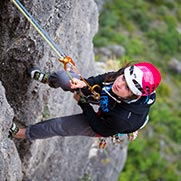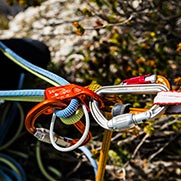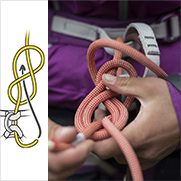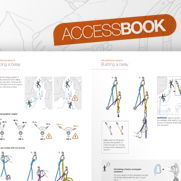Belay loop and tie-in points: where do I attach my lanyard, my belay device and my rope?
The front part of a climbing harness usually has a belay loop and two tie-in points. These parts provide a place to attach a lanyard, a belay device and a rope.
Warnings
- Carefully read the Instructions for Use used in this technical advice before consulting the advice itself. You must have already read and understood the information in the Instructions for Use to be able to understand this supplementary information.
- Mastering these techniques requires specific training. Work with a professional to confirm your ability to perform these techniques safely and independently before attempting them unsupervised.
- We provide examples of techniques related to your activity. There may be others that we do not describe here.
1. Where do I attach my lanyard?
From a safety and strength perspective, the lanyard can be attached to the belay loop or to the two tie-in points. But as a matter of comfort, it is preferable to attach your lanyard to the belay loop.
Petzl recommends attaching your lanyard to the belay loop.
The lanyard attached to the belay loop helps maintain good harness geometry without affecting comfort. It allows the tie-in points to move freely and does not hinder the climber’s mobility. It also keeps the tie-in points clear, for attaching a single rope or two half ropes.
A lanyard attached to the two tie-in points brings the upper and lower parts of the harness closer together. This reduces the climber’s comfort and mobility.
2. Where do I attach my belay device?
A common error is to attach the belay device to the two tie-in points instead of to the belay loop. WARNING: when connected to the two tie-in points, the carabiner will not be properly loaded.
The belay device must always be attached to the belay loop.
This attachment allows the belay device to move freely and helps prevent cantilever loading of the carabiner.
WARNING: when the belay device is attached to the two tie-in points of a harness, the carabiner is not free to move and becomes loaded on the minor axis:
- there is a risk of the carabiner breaking if the climber falls
- there is a risk of the carabiner gate opening
3. Where do I attach my rope?
From a safety and strength perspective, there is no risk in tying in with a figure-eight knot or a bowline knot on the belay loop instead of to the two tie-in points.
But as a matter of durability and wear, it is preferable to tie in to the two tie-in points.
Petzl recommends tying in to the two tie-in points.
The tie-in points were designed to be loaded frequently by the rope (repeated climber falls while working a route). They are reinforced with protective webbing and are thus more wear-resistant. Also, on certain harnesses, a red wear indicator incorporated into the tie-in points helps you know when the harness should be retired. This makes it easier to inspect your equipment.
Tying in to the belay loop is reserved for mountaineering where falls are rare, as with the ALTITUDE and TOUR harnesses for example.
Repeated falls on the belay loop when sport climbing will result in premature wear of the harness.
WARNING: be sure to take care when tying in.
Once everything is set up, remember to do a partner check before starting to climb:








